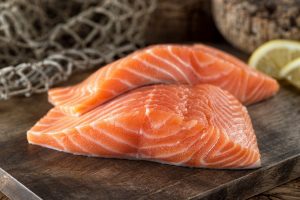
And guess what? That info can be pretty important.
Because not all salmon are “created” equally.
Some salmon is rich in omega-3 fatty acids, an essential fat that humans do not produce on their own. Omega-3’s are noted for playing important roles in heart health, brain health, cholesterol levels, brain function, inflammation, and more.
But those benefits are linked, largely, to wild salmon. Farmed salmon, on the other hand, even given the deceptive “organic” label, lags far behind in nutrition, according to experts.
While farmed salmon boasts an impressive nutrient profile, rich in omega 3, vitamin D (one of the few food sources of this important vitamin), iron, zinc, and potassium, farmed salmon has much less.
It also has some things you might not want, like potentially harmful contaminants, saturated fat, and pro-inflammatory omega-6 fatty acids. The higher levels of saturated fat and omega-6’s are likely the result of the diet these fish are fed and the fact that they don’t spend their lives swimming upstream.
So, when you’re looking to buy salmon to improve the overall health if your diet, wild salmon is the way to go. But how can you tell the difference? Here are some tips that might help you distinguish between farmed and wild (if it’s not written on a label).
The color. Farmed salmon will have a light pink hue and more white marbling. Wild salmon, on the other hand, will be more a deep, reddish-orange colour.
The price point: Wild salmon is going to have a higher price than farmed. You’ll be unlikely to find it for less than $10 per pound. Put simply, you get what you pay for.
The origin: If it comes from Alaska (in the U.S.) or British Columbia (in Canada), it is likely wild and fished sustainably. Almost all Atlantic salmon (east) is farmed. It’s also a safe bet that most restaurant salmon unless noted, is farmed.
The time of year: Salmon season typically runs from May-September, so if you’re buying it in that range, it is likely wild.